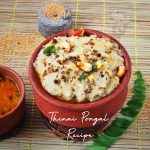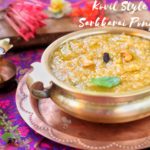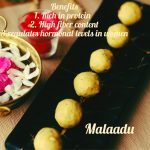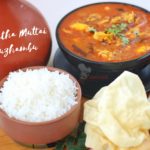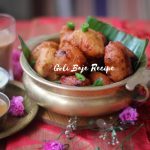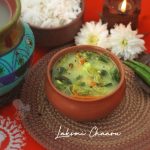Relish this exotically luscious Milagu Pongal which is soft and has a toothsome texture that melts in your mouth...
An Overview On Milagu Pongal:
There is something exceptional about the Indian food that evokes extreme fervor from all who take pride in its food culture. There are a slew of options for breakfast wherein you get overwhelmed with the choices given and with appropriate accompaniments the dishes not only satisfy your stomach but also fulfills your soul. There is a huge list of dishes that can be both nourishing and as well as tasty besides being soothing and comfortable to have at any part of the day. Milagu Pongal is one such awesome dish which is famous all over the country especially in the South, is much adored as a comfort food and commonly cooked at home for a Sunday brunch or during holidays. Nevertheless, it is popular at all restaurants whether it a small eatery or an iconic establishment this sumptuous Milagu Pongal is supplied for breakfast, evening snack and dinner as well. Milagu Pongal becomes all the more delectable with its alluring accompaniments like spicy tangy vengaya sambhar, creamy coconut chutney, fiery onion chutney and reaches its zenith with a sizzling hot medu vada. You attain ultimate bliss finally when you slurp in a sip of aromatic filter coffee in between. The way in which it is served is yet again a tantalizing temptation both to our eyes and as well as our palates. Almost in all the restaurants, it is served either directly in a banana leaf or in a plate (where the leaf is placed over the plate) and the flavorful Milagu pongal is scooped over it with a dash of aromatic ghee. Then the accompaniments are served one by one and they are refilled endlessly so that we can devour our Milagu Pongal without any hindrance till the end. Medu Vada and Milagu pongal are always served together as they go well with each other and they are almost inseparable and honestly speaking, personally I just cant imagine relishing Milagu Pongal without a Medu Vada. We feel something missing in case if it is served otherwise and I have seen people cancel and change the items due to the non availability of Medu Vada. The combination is so addictive that if the waiter gives us a choice to replace the medu vada with some bajji or bonda along with the pongal, we would say no instantaneously without a second thought. Many of the pongal lovers would have had this experience and would agree to what I say.
The difference between Ven pongal and Milagu Pongal:
With almost all the ingredients being the same, Milagu pongal just comes with a subtle difference. Here the ginger is used minimally and the flavor of black pepper predominates the dish. And you add a little more ghee than the ven pongal and all the other things are similar including the accompaniments. Any bland chutney like coconut chutney or groundnut chutney and plain or shallots sambhar go well with the Milagu Pongal.
Benefits of serving pongal (any dish) in banana leaf:
It is a common sight to see food being served in banana leaf all over India and if we take a sneak peek into the origin of this practice it gives us some astounding results. Serving food in banana leaf has been in practice since ages and still it continues in all parts of India. We will be simply taken aback by the intelligence and the knowledge of our ancestors if we get to know fully about the benefits of eating in a banana leaf. Let us get to know a few highlights about this miracle leaf so that we can be benefited and we can also pass it on to the next generation.
Besides being healthy and hygienic, eating on a banana leaf has been considered auspicious and preferred for offerings to God till date. There are plenty of reasons behind this iconic tradition of India, and even today banana leaf plays an important role in Ayurveda.
Eating hot food on a banana leaf enables in getting the nutrients from the leaf and the antibacterial properties present in the leaf makes the food germ free before it gets into our mouth. It has rich anti oxidants required for our body and the polyphenols that exist in banana leaf reduces free radicals thereby preventing our body against several diseases. Eating on a banana leaf feels more tastier and delicious and certainly there lies a fact behind it. There is a wax coating on the top of the leaf and when hot food touches the coating it just melts down making the food more delectable.
Enjoy your food especially this Milagu Pongal on a banana leaf and enjoy its benefits to the fullest.
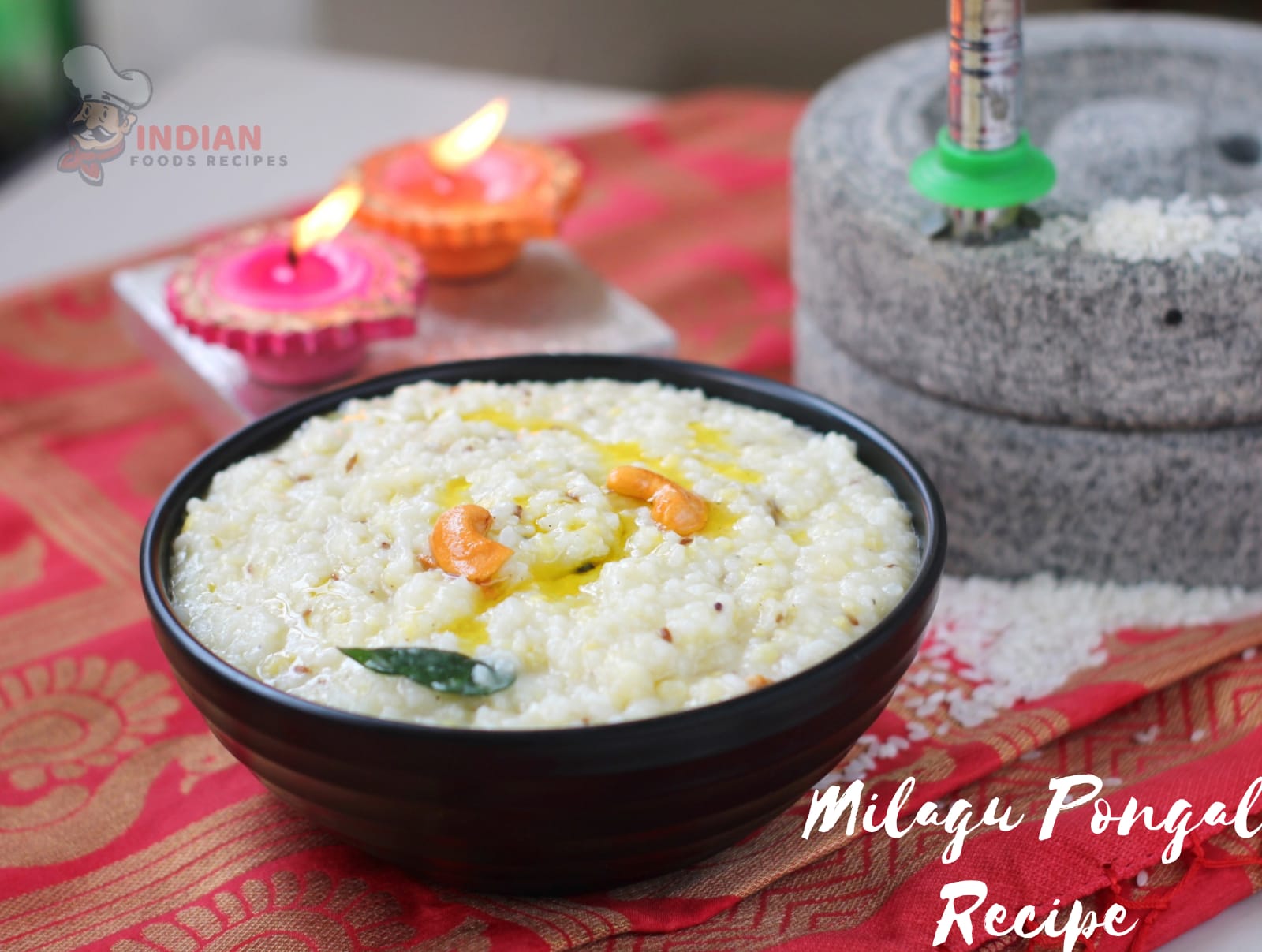
Ingredients Required To Make Milagu Pongal Recipe :
How To Make Milagu Pongal Recipe :
Add the measured quantities of rice and dhal in two separate vessels and soak it for about twenty minutes after rinsing it well. Take a thick bottomed pot (vengala panai) and pour in four and a half to five cups of water and place it over a stove. Turn on and let the flame be in high mode. When the water starts to boil, plop in the soaked dal and stir in and gently alter the flame to low medium mode. Keep stirring now and then with a long ladle and let it get cooked for a few minutes.
After a while, when the dhal gets cooked up well, gently squirt in the soaked rice and stir in for about ten to fifteen minutes on and off. After some time, when the rice gets cooked up well, sprinkle in the required salt and stir well. Let it get boiled for a while and when the rice turns mushy and aromatic just do the tempering.
Heat a small pan and pour in a tablespoon of ghee and after a few seconds add the measured quantities of peppercorns, cumin seeds, grated ginger and curry leaves. Tip in a pinch of asafoetida along with it and finally throw in some roughly torn curry leaves and let it all to sizzle for a second or two. Gently add the tempered ingredients to the rice while it still splutters and at last do the garnishing. Heat the small pan again and tip in one or two tablespoons of ghee as per your requirement, and when it is heated add some cashew nuts and when it turns golden brown plop it into the pongal. Now the delicious milagu pongal is ready to serve.
Take a lush green plantain leaf and wash it well. Take a ladle full of milagu pongal and place it at the middle of plantain leaf while it is still hot and sizzling. Sprinkle a few drops of ghee on top and serve it along with shallots sambhar, coconut chutney and medu vada.
Tips:
* New raw rice serves the best for making milagu pongal and you need to soak the rice for about ten to fifteen minutes before cooking to get a squishy finish.
* Making Milagu pongal in a pot ( bronze, brass, earthen or stainless steel) is as easy as making it in a pressure cooker. It is only a misconception that the process is laborious and quite tough. Although it may consume a little more time than pressure cooking it is actually more delicious and hassle-free as it is just a one pot dish. The final output is worth the effort and the time you put in.
* We may also assume that the rice may get scorched in a pot but in fact it can be prepared with zero percent scorch if we follow certain nuances. Apart from choosing a heavy bottomed pot, adding the required amount of water and stirring in continuously with a long and sturdy ladle will definitely give a perfect outcome. Patience is the key to get the authentic milagu pongal.
* Coconut chutney and plain sambhar go well with milagu pongal and let the sambhar and chutney be less spicy as milagu pongal is already hot and fiery.
* You can retain the milagu pongal in the same pot for more than a day depending upon the climate of the place you live in and can refrigerate for about three to four days approximately.
Ingredients
Directions
Add the measured quantities of rice and dhal in two separate vessels and soak it for about twenty minutes after rinsing it well. Take a thick bottomed pot (vengala panai) and pour in four and a half to five cups of water and place it over a stove. Turn on and let the flame be in high mode. When the water starts to boil, plop in the soaked dal and stir in and gently alter the flame to low medium mode. Keep stirring now and then with a long ladle and let it get cooked for a few minutes.
After a while, when the dhal gets cooked up well, gently squirt in the soaked rice and stir in for about ten to fifteen minutes on and off. After some time, when the rice gets cooked up well, sprinkle in the required salt and stir well. Let it get boiled for a while and when the rice turns mushy and aromatic just do the tempering.
Heat a small pan and pour in a tablespoon of ghee and after a few seconds add the measured quantities of peppercorns, cumin seeds, grated ginger and curry leaves. Tip in a pinch of asafoetida along with it and finally throw in some roughly torn curry leaves and let it all to sizzle for a second or two. Gently add the tempered ingredients to the rice while it still splutters and at last do the garnishing. Heat the small pan again and tip in one or two tablespoons of ghee as per your requirement, and when it is heated add some cashew nuts and when it turns golden brown plop it into the pongal. Now the delicious milagu pongal is ready to serve.
Take a lush green plantain leaf and wash it well. Take a ladle full of milagu pongal and place it at the middle of plantain leaf while it is still hot and sizzling. Sprinkle a few drops of ghee on top and serve it along with shallots sambhar, coconut chutney and medu vada.


